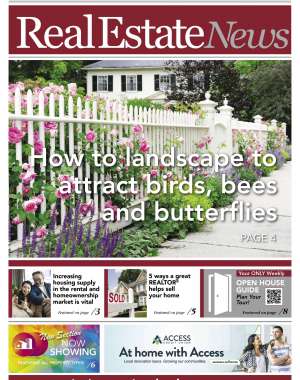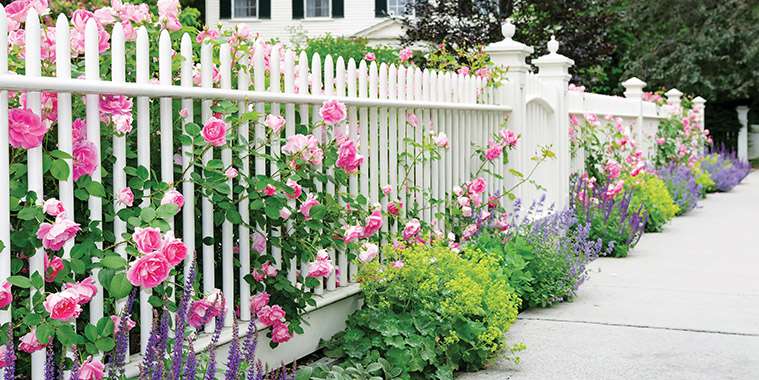Now that summer is in full swing, and the heat is really coming on strong, we’re paying extra attention to our yards. Or just lounging in the sunshine with a cold lemonade. It’s all good.
But don’t relax just yet. It’s important to pay attention to the habitat our yards create for much smaller creatures than ourselves.
Climate change and habitat loss have disrupted the routine of our migrant birds, bees and butterflies — and their work is just beginning. There are nests to build, hives to feed and flowers to pollinate.
There’s no denying the buzz: our precious bees need some extra love and affection. With some careful landscape consideration, you can easily create an all-inclusive backyard that’s both bird, butterfly and bee-friendly.
To make one pound of honey, bees must visit more than two million flowers. One beehive (colony population: 80,000) must fly nearly 80,500 km, with each bee visiting 50 to 100 flowers during one ‘collection flight’ from the hive. So plant more flowers. Easy.
Pollinator checklist
Pollinator-friendly plants like bee balm, Russian sage, butterfly bush, dianthus, coneflower and pasques (prairie crocus) add a fragrant and vibrant texture to a backyard (or balcony in a pinch). Visit your local garden centre or Fernlea’s online greenhouse for ideas. Bees love blue, purple and yellow blooms, so you can negotiate with your preferences. Flat and single-petal flowers like the Black-eyed Susan are the easiest for bees to navigate. Perennials do the dirty work for you — plant them once and they will return the favour year after year.
Take advantage of Manitoba’s own T&T Seeds for ideas, tips and even a live chat on their website at ttseeds.com if you have questions about their products. They’ll deliver right to your door. For a safe and easy shopping experience, many garden retailers are offering curbside pick-up and some offer delivery, too. Visit your local garden centre’s Facebook page or website first for photos of plants, updates and availability.
Pest peeves
Every gardener will have a nemesis — it’s wild out there! Natural pest protection is a responsible way to find common ground without damaging the environment. Certain herbs, ladybugs and burning sage can ward off a few of the invaders. For little two-legged invaders, teach children to appreciate the work of the humble bumble. They are docile and more interested in collecting their daily pollen than stinging humans.
Hummingbird 101
If you’re new to the scene, it’s all about location. Hanging feeders in an area safe from curious cats and away from reflective windows that could result in fatal collisions is paramount. Despite advertising and good ol’ fashioned folklore, using red food colouring or dye is not advisable. The feeders are generally made of red components that immediately attract hummingbirds.
The no-fail recipe for the solution is simple: one-part sugar, four parts boiled water. Be sure to let the formula cool before filling your feeder and wash it frequently (with hot water and eco-friendly soap or vinegar), especially during summer. Due to the sticky nature of the solution, you may need a toothpick, brush or Q-tip to unclog the feeding portals. The hummingbirds will become accustomed to your feeder, so mark their arrival in the spring on your calendar!
Hummingbirds also love the tubular Foxglove, Trumpet Vine, Columbine and Butterfly Weed.
The housing market
Mason bees do not use traditional hives. They resourcefully choose holes pre-drilled by beetles or woodpeckers to lay their eggs. The typical bundles of bamboo tubes or drilled holes that make up a mason bee house or hive provide a place for wild bees to collect pollen and reproduce. You can purchase ready-made mason bee houses, but why not make one?
Birdhouse offerings run parallel with our real estate listings. Some are fixer-uppers while others have great curb appeal but lack square footage and function. The adage ‘there’s a house for everyone,’ is applicable to birds, too — though they often choose their homes by the size of the entrance hole.
While barn swallows and robins prefer a shelf design, Eastern bluebirds are very particular. Size matters! Purple martins love condo/apartment-style living while a woodpecker will search for an unfinished house. It’s all about amenities — is there a bird bath nearby? A feeder full of seed? Milkweed?
The land of milkweed and honey
If you plant milkweed, you’ll make both the Monarch butterfly and American Goldfinch happy. Goldfinches use milkweed fiber to line their nests. While sunflowers are cherished, birds like woodpeckers love their trees: elderberry, sumac, dogwood and oak provide fruit, acorns, insects and some desirable nesting cavities if there’s no room at the inn.
Once you’ve tended to the birds, bees and butterflies, it’s playtime! Sit back and watch them enjoy your gardening efforts.
— Realtor.ca



